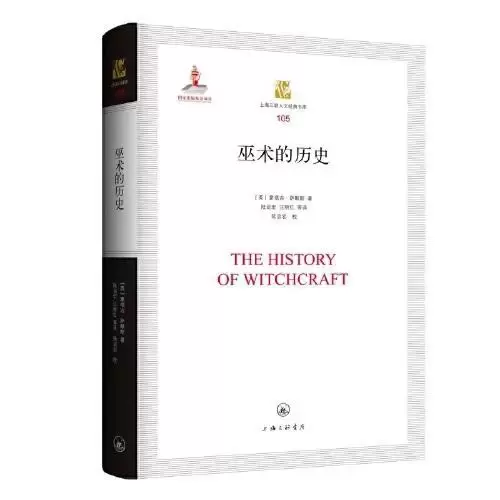
作者:[英]蒙塔古·萨默斯
出版社:上海三联书店
译者:陆启宏
出版年:2020-9-1
页数:348
定价:78.00元
装帧:精装
丛书:上海三联人文经典书库
ISBN:9787542665188
内容简介
······
在本书中,读者会经常碰到玛格丽特·默里(MargaretMurray)这个名字,并且会明白她是萨默斯强大的对手。默里认为,巫术是由朋友和敌人传播与信仰的,她反对“开明的”历史学家将此视为暂时的疯狂。当萨默斯引用默里的观点时,他们的争论加剧了。默里小姐的观点遭到了强烈的指责。然而,萨默斯并没有解释这些观点是什么。
我大体上同意默里小姐的观点,我认为重要的是让读者明白这些观点是什么。默里小姐在《西欧的巫术崇拜》(The Witch Cult of Western Europe)和《女巫的上帝》(The God of the Witches)这两本卓越的著作中以及用《大英百科全书》中一个非常简要的条目将这些观点阐释得很清楚。我相信,默里小姐为百科全书写词条意味着她的观点现在很流行,但不幸的是情况并非如此。默里首先指出女巫来自智者。女巫的知识通常是预言,“当以正统宗教的某位神祗的名义进行,这就是预言;当以某位异教神祗的名义进行,这就是巫术”。Devit这个词是一个指小词缀,其来自词根div,从这个词根我们还可以得到divine这个词,而devil仅仅指“小神”。“众所周知的事实是,当一个新的宗教在一个国家建立时,旧宗教的神祗就变成了新宗教的恶魔。在研究中世纪女巫的记录时,我们处理的正是异教的残余,这一异教至少在英格兰一直存在到18世纪,即自基督教引入后持续了1200年。古代信仰的实践可以在当今的法国看到;在意大利,尽管基督教会不断努力,旧宗教仍然拥有很多追随者。”
如果不存偏见地进行描写,那么欧洲女巫的异教信仰对于《金枝》(The Golden Bough)或其他人类学作品的读者来说是相当熟悉的,其核心是化身为人或动物的神,在集会或巫魔会上穿着黑衣或伪装成各种动物形象出现在崇拜者面前。默里小姐让我们想起其与希腊人的神圣婚姻或罗马人的农神狂欢是何等相似,而萨默斯所描写的性狂欢则完全不同。使用咒语、药物等方法对付敌人无疑属于前文字时代,但是没有任何客观的比较宗教学学者会断言女巫比她们基督教的后继者犯下了更可怕的罪行。
对于有兴趣的读者来说,他们非常容易获得默里小姐那些大量的引人人胜的材料。关键是,默里小姐使我们确信,在巫术的名义下流传下来的是一种被基督教战胜的宗教,它的术语及对其仪式的描写都是由胜利者来书写的。
基督教征服者将被打败的宗教的核心归纳为与撒旦签订契约。如赫伯特·瑟斯顿(Herbert Thurston)在《天主教百科全书》关于巫术的词条中告诉我们的,“不仅在黑暗时代的传统信仰中,而且在宗教改革之后的信仰中,女巫都与撒旦签订契约”。与撒旦签订契约似乎是基督教时代的创造。《旧约》中尽管要求处死女巫,但并没有提到契约。
萨默斯避免处理如下问题,即为什么针对巫术的主要斗争出现在13世纪中叶之后——当时宗教裁判所被建立起来。1484年,教皇英诺森八世的训谕掀起了大规模的斗争。从16世纪直至18世纪,消灭女巫的活动一直残酷地进行着。学者们所估计的被处死女巫的数量存在很大差异,从三万到几百万不等。根据记录不可能知道数字,但显然有大量的人被处死。关于斗争为什么结束,答案很明显:一方面,基督教取得了完全的胜利;另一方面,理性主义精神出现并否认了巫术的魔法效力。但是,为什么针对巫术的斗争在15世纪开始扩大和加剧?萨默斯回避了这个问题。
作者简介
······
Augustus Montague Summers (10 April 1880 – 10 August 1948) was an English author and clergyman. He is known primarily for his scholarly work on the English drama of the 17th century, as well as for his idiosyncratic studies on witchcraft, vampires, and werewolves, in all of which he professed to believe. He was responsible for the first English translation, published in 1928, of the 15th-century witch hunter's manual, the Malleus Maleficarum.Summers' career as an ostensibly Catholic clergyman was highly unusual. Although he wrote works of hagiography on Catherine of Siena and Anthony Maria Zaccaria, his primary religious interest was in the subject of the occult. While Aleister Crowley, with whom he was acquainted, adopted the persona of a modern-day witch, Summers played the part of the learned Catholic witch-hunter. In the introduction to his book on The History of Witchcraft and Demonology (1926) he writes:
In the following pages I have endeavoured to show the witch as she really was – an evil liver: a social pest and parasite: the devotee of a loathly and obscene creed: an adept at poisoning, blackmail, and other creeping crimes: a member of a powerful secret organisation inimical to Church and State: a blasphemer in word and deed, swaying the villagers by terror and superstition: a charlatan and a quack sometimes: a bawd: an abortionist: the dark counsellor of lewd court ladies and adulterous gallants: a minister to vice and inconceivable corruption, battening upon the filth and foulest passions of the age.
In 1928, he published the first English translation of Heinrich Kramer's Malleus Maleficarum ("The Hammer of Witches"), a 15th-century Latin manual on the hunting of witches. In his introduction, Summers insists that the reality of witchcraft is an essential part of Catholic doctrine and declares the Malleus an admirable and correct account of witchcraft and of the methods necessary to combat it. In fact, however, the Catholic authorities of the 15th century had condemned the Malleus on both ethical and legal grounds.[4] Other Catholic scholars contemporary with Summers were also highly critical of the Malleus. For instance, the Rev. Herbert Thurston's article on "Witchcraft" for the Catholic Encyclopaedia of 1912, refers to the publication of the Malleus as a "disastrous episode."[5]
Montague Summers then turned to vampires, producing The Vampire: His Kith and Kin (1928) and The Vampire in Europe (1929), and later to werewolves with The Werewolf (1933). Summers' work on the occult is notorious for his unusual and old-fashioned writing style, his display of erudition, and his purported belief in the reality of the subjects he treats.
目录
······
序
导论
第一章 女巫:异端和无政府主义者
第二章 巫术崇拜
第三章 恶魔和精灵
第四章 巫魔会
第五章 《圣经》中的女巫
第六章 着魔与现代招魂术
第七章 戏剧文学中的女巫
索引
译后记
评论 ······
可能是国内第一本真正涉及到恶魔学的著作。因作者先入为主 全书都是在证明和维护恶魔真实性展开。所以里面看不到依靠逻辑的论证。但里面大量恶魔学资料和教会对恶魔学的看法都被罗列好了。在中文资料中非常有价值。
稍微翻了翻,感觉很不舒服而且没意思,神神叨叨的。
啐!!!只会骂异教骂女巫的秃驴。滚啊老疯子!
不好意思,当八卦读了,但还蛮有趣的。作为一名罗马天主教教士,Summers极力辩护教会在异端审判和猎巫运动中的正当性,因此他对巫术深信不疑,这成就了本书矛盾也有趣的奇异角度。
作为分析材料来看其实挺不错的,无神论旁观者也可以从中窥见另一种逻辑是如何运作的。在宗教语境下女巫和恶魔的存在是一种必然,从最初的外部他者“异教”到后来的内部他者“异端”和“魔鬼”,这个发展过程既体现了基督教势力的扩大也是基督教对世界的解释不断完善的过程。对于无法回避的“恶”的存在就只能寻求一个异己来承载。同时,这样一个异己也是证明教会威力与合法性的对象,所以萨默斯这样的教士不得不为巫术和恶魔的存在…
评论前必须登录!
注册